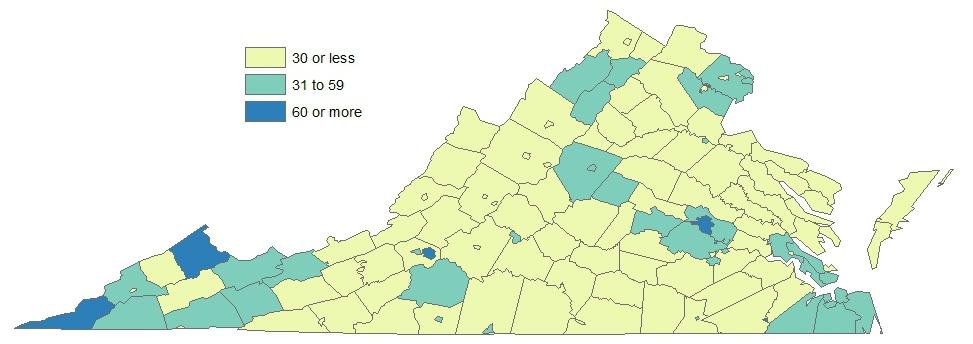Residential segregation in Virginia’s counties and cities
The Weldon Cooper Center released a report today examining geographic and demographic changes in Virginia’s black population over time: Blacks in Virginia: Demographic Trends in Historical Context. One topic in the report is the continued residential segregation of blacks in Virginia’s big metropolitan centers. I thought it would be interesting, as well, to have a look at segregation in all of Virginia’s localities.
First, some background. Residential segregation is most commonly measured with something called the index of dissimilarity. Here, we’ll measure how evenly blacks and whites are distributed across the census tracts within each county or city, based on the 2010 Census. The dissimilarity value can be anything from 0, complete integration (the proportion of blacks and whites in each census tract equals the proportion of blacks and whites in the county overall) , to 100, complete segregation (all of the blacks live in census tracts with no whites and all of the whites live in census tracts with no blacks).
The dissimilarity value is often interpreted as the percent of one of the groups who would need to move to a new census tract in order to achieve a balanced distribution. Demographers usually consider values of 60 or more as representing high levels of residential segregation and values of 30 or less as representing low levels of residential segregation.
Got it? Good. (And if not, that’s okay; keep reading…)
So what does Virginia look like?

Most localities have low levels of racial residential segregation (dissimilarity values of 30 or less, though the measure is meaningless for the seven localities with only one census tract). There are identifiable pockets of moderate residential segregation by race throughout Virginia – in northern Virginia, the Richmond region, Hampton Roads, Albemarle-Charlottesville, and the southwest counties.
But only five localities are at the 60 or above mark: Lee County, Franklin City, Richmond City, Buchanan County, and Roanoke City.
What’s up with those counties out west? How can counties with small black populations have such high dissimilarity scores? A couple of examples will help illuminate.
In counties with a high measure of residential segregation, the black population is clustered into a handful of census tracts. Take Lee: Lee has a dissimilarity value of 76 though only 4% of the population is black. Lee is divided into six census tracts, and the percent of each that is black and white is listed in the first columns below.
| Census Tract | Lee County, Dissimilarity: 76, Percent black: 4 | Wise County, Dissimilarity: 42, Percent black: 5 | Alleghany County, Dissimilarity: 30, Percent black: 5 | |||
| % White | % Black | % White | % Black | % White | % Black | |
| 1 | 98.5 | 0.3 | 82.9 | 15.7 | 86.1 | 10.1 |
| 2 | 98.2 | 0.5 | 98.9 | 0.5 | 94.3 | 3.9 |
| 3 | 78.4 | 16.1 | 97.2 | 0.7 | 93 | 4.3 |
| 4 | 98.2 | 0.4 | 98.8 | 0.5 | 97.6 | 1.6 |
| 5 | 98.6 | 0.3 | 96.8 | 1.9 | 97.4 | 1.7 |
| 6 | 98.8 | 0.1 | 82.4 | 15.3 | 96.8 | 2.1 |
| 7 | 97.6 | 0.9 | ||||
| 8 | 94.1 | 3.0 | ||||
| 9 | 94.5 | 3.9 | ||||
| 10 | 96.9 | 1.3 | ||||
| 11 | 97.1 | 0.7 | ||||
Complete integration would mean that 4% of every tract is black, but one tract is quadruple that and the others are far, far below that number. In fact, 94 percent of the blacks who live in Lee live in the same census tract (tract 3).
This pattern is less stark in counties with moderate dissimilarity scores, like Wise. Wise is divided into 11 census tracts and has a black population of 5% and a dissimilarity value of 42. Approximate integration would require each census tract to be about 5% black, but two tracts are triple that and the rest are far below. In Wise, 75 percent of the blacks are concentrated in two tracts (tracts 1 and 6)
But in Alleghany, where 5% of the population is black and the dissimilarity value is a relatively low 30, the percent black in each tract hovers much more closely around 5%. In Alleghany, just over half of the black population is in the same census tract (tract 1, with 52%).
We tend to think of residential racial segregation as a problem of urban areas, but blacks and whites can live in very separate neighborhoods everywhere, when blacks are a majority (the cities of Franklin and Richmond) or a small minority (Lee and Buchanan county). On the other hand, the reverse is also true.
To read more about why this matters, see the report.


